Nanosonics Limited Report: Contemporary Accounting Theory, ACCT20074
VerifiedAdded on 2022/10/01
|18
|4632
|25
Report
AI Summary
This report delves into the critical role of sustainability and corporate social responsibility (CSR) in enhancing a company's financial performance. It begins with a theoretical overview, presenting a literature review that underscores the importance of CSR for organizations. The report then compares sustainability reporting with other reporting concepts and explores two key theories: stakeholder theory and agency theory, to provide a deeper understanding of sustainability reporting. The second part of the report provides a practical analysis by examining Nanosonics Limited, an ASX-listed company, including its history, ownership, governance, and financial performance. It evaluates the company's sustainability reporting using a scoring index based on Global Reporting Initiative (GRI) guidelines, analyzing the extent and quality of its CSR initiatives. The report concludes with a summary of findings and insights.
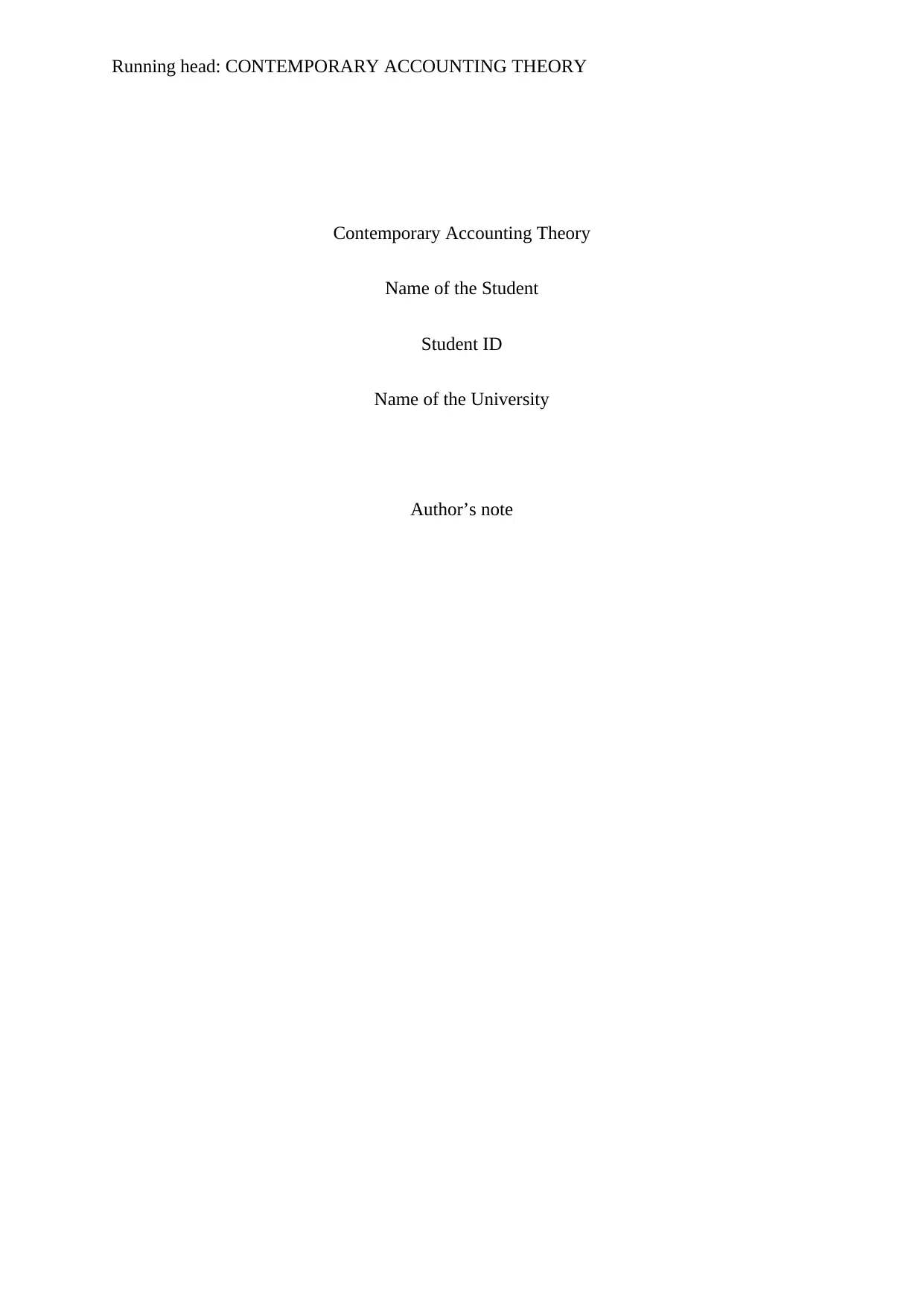
Running head: CONTEMPORARY ACCOUNTING THEORY
Contemporary Accounting Theory
Name of the Student
Student ID
Name of the University
Author’s note
Contemporary Accounting Theory
Name of the Student
Student ID
Name of the University
Author’s note
Paraphrase This Document
Need a fresh take? Get an instant paraphrase of this document with our AI Paraphraser
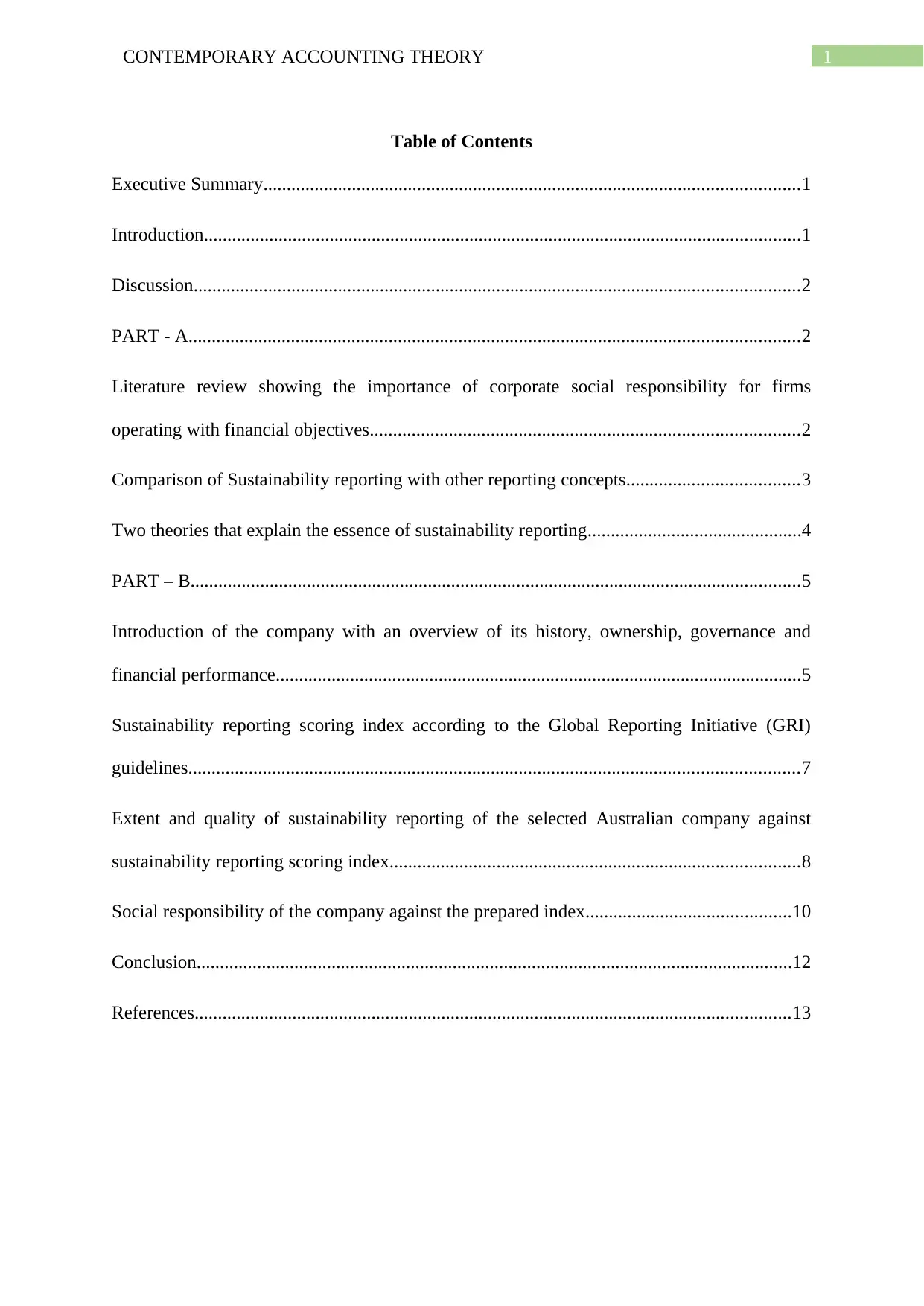
1CONTEMPORARY ACCOUNTING THEORY
Table of Contents
Executive Summary...................................................................................................................1
Introduction................................................................................................................................1
Discussion..................................................................................................................................2
PART - A...................................................................................................................................2
Literature review showing the importance of corporate social responsibility for firms
operating with financial objectives............................................................................................2
Comparison of Sustainability reporting with other reporting concepts.....................................3
Two theories that explain the essence of sustainability reporting..............................................4
PART – B...................................................................................................................................5
Introduction of the company with an overview of its history, ownership, governance and
financial performance.................................................................................................................5
Sustainability reporting scoring index according to the Global Reporting Initiative (GRI)
guidelines...................................................................................................................................7
Extent and quality of sustainability reporting of the selected Australian company against
sustainability reporting scoring index........................................................................................8
Social responsibility of the company against the prepared index............................................10
Conclusion................................................................................................................................12
References................................................................................................................................13
Table of Contents
Executive Summary...................................................................................................................1
Introduction................................................................................................................................1
Discussion..................................................................................................................................2
PART - A...................................................................................................................................2
Literature review showing the importance of corporate social responsibility for firms
operating with financial objectives............................................................................................2
Comparison of Sustainability reporting with other reporting concepts.....................................3
Two theories that explain the essence of sustainability reporting..............................................4
PART – B...................................................................................................................................5
Introduction of the company with an overview of its history, ownership, governance and
financial performance.................................................................................................................5
Sustainability reporting scoring index according to the Global Reporting Initiative (GRI)
guidelines...................................................................................................................................7
Extent and quality of sustainability reporting of the selected Australian company against
sustainability reporting scoring index........................................................................................8
Social responsibility of the company against the prepared index............................................10
Conclusion................................................................................................................................12
References................................................................................................................................13
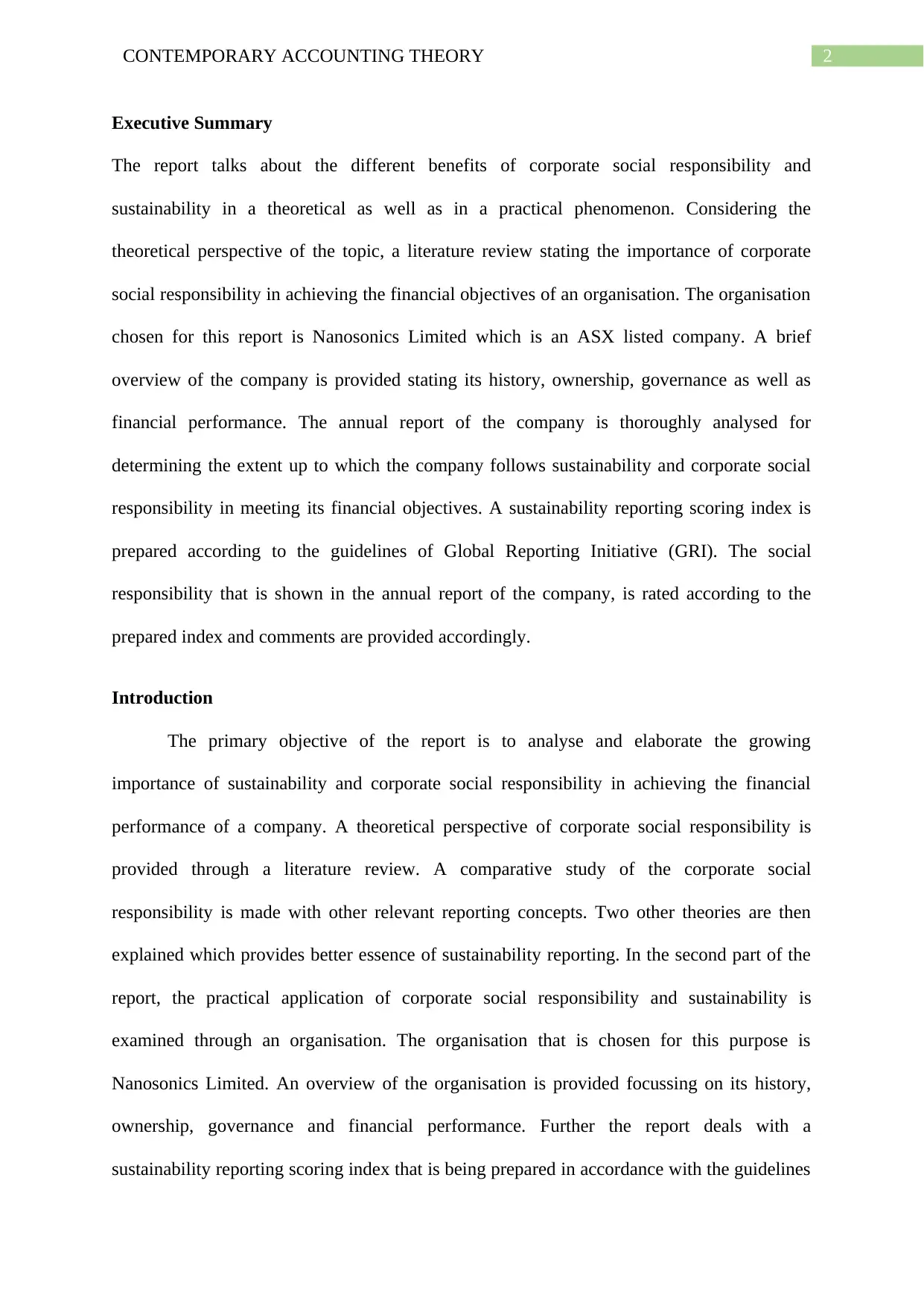
2CONTEMPORARY ACCOUNTING THEORY
Executive Summary
The report talks about the different benefits of corporate social responsibility and
sustainability in a theoretical as well as in a practical phenomenon. Considering the
theoretical perspective of the topic, a literature review stating the importance of corporate
social responsibility in achieving the financial objectives of an organisation. The organisation
chosen for this report is Nanosonics Limited which is an ASX listed company. A brief
overview of the company is provided stating its history, ownership, governance as well as
financial performance. The annual report of the company is thoroughly analysed for
determining the extent up to which the company follows sustainability and corporate social
responsibility in meeting its financial objectives. A sustainability reporting scoring index is
prepared according to the guidelines of Global Reporting Initiative (GRI). The social
responsibility that is shown in the annual report of the company, is rated according to the
prepared index and comments are provided accordingly.
Introduction
The primary objective of the report is to analyse and elaborate the growing
importance of sustainability and corporate social responsibility in achieving the financial
performance of a company. A theoretical perspective of corporate social responsibility is
provided through a literature review. A comparative study of the corporate social
responsibility is made with other relevant reporting concepts. Two other theories are then
explained which provides better essence of sustainability reporting. In the second part of the
report, the practical application of corporate social responsibility and sustainability is
examined through an organisation. The organisation that is chosen for this purpose is
Nanosonics Limited. An overview of the organisation is provided focussing on its history,
ownership, governance and financial performance. Further the report deals with a
sustainability reporting scoring index that is being prepared in accordance with the guidelines
Executive Summary
The report talks about the different benefits of corporate social responsibility and
sustainability in a theoretical as well as in a practical phenomenon. Considering the
theoretical perspective of the topic, a literature review stating the importance of corporate
social responsibility in achieving the financial objectives of an organisation. The organisation
chosen for this report is Nanosonics Limited which is an ASX listed company. A brief
overview of the company is provided stating its history, ownership, governance as well as
financial performance. The annual report of the company is thoroughly analysed for
determining the extent up to which the company follows sustainability and corporate social
responsibility in meeting its financial objectives. A sustainability reporting scoring index is
prepared according to the guidelines of Global Reporting Initiative (GRI). The social
responsibility that is shown in the annual report of the company, is rated according to the
prepared index and comments are provided accordingly.
Introduction
The primary objective of the report is to analyse and elaborate the growing
importance of sustainability and corporate social responsibility in achieving the financial
performance of a company. A theoretical perspective of corporate social responsibility is
provided through a literature review. A comparative study of the corporate social
responsibility is made with other relevant reporting concepts. Two other theories are then
explained which provides better essence of sustainability reporting. In the second part of the
report, the practical application of corporate social responsibility and sustainability is
examined through an organisation. The organisation that is chosen for this purpose is
Nanosonics Limited. An overview of the organisation is provided focussing on its history,
ownership, governance and financial performance. Further the report deals with a
sustainability reporting scoring index that is being prepared in accordance with the guidelines
⊘ This is a preview!⊘
Do you want full access?
Subscribe today to unlock all pages.

Trusted by 1+ million students worldwide
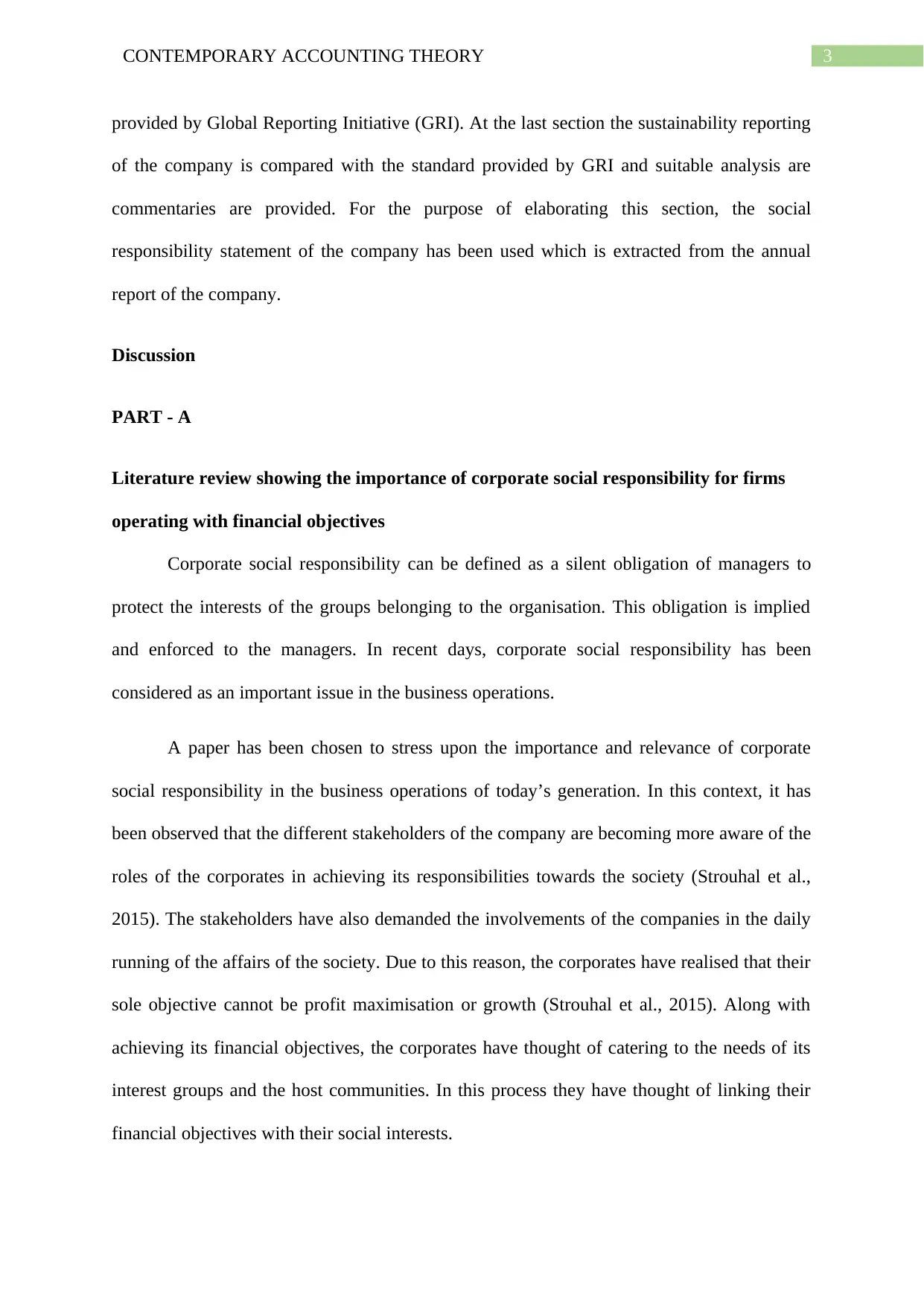
3CONTEMPORARY ACCOUNTING THEORY
provided by Global Reporting Initiative (GRI). At the last section the sustainability reporting
of the company is compared with the standard provided by GRI and suitable analysis are
commentaries are provided. For the purpose of elaborating this section, the social
responsibility statement of the company has been used which is extracted from the annual
report of the company.
Discussion
PART - A
Literature review showing the importance of corporate social responsibility for firms
operating with financial objectives
Corporate social responsibility can be defined as a silent obligation of managers to
protect the interests of the groups belonging to the organisation. This obligation is implied
and enforced to the managers. In recent days, corporate social responsibility has been
considered as an important issue in the business operations.
A paper has been chosen to stress upon the importance and relevance of corporate
social responsibility in the business operations of today’s generation. In this context, it has
been observed that the different stakeholders of the company are becoming more aware of the
roles of the corporates in achieving its responsibilities towards the society (Strouhal et al.,
2015). The stakeholders have also demanded the involvements of the companies in the daily
running of the affairs of the society. Due to this reason, the corporates have realised that their
sole objective cannot be profit maximisation or growth (Strouhal et al., 2015). Along with
achieving its financial objectives, the corporates have thought of catering to the needs of its
interest groups and the host communities. In this process they have thought of linking their
financial objectives with their social interests.
provided by Global Reporting Initiative (GRI). At the last section the sustainability reporting
of the company is compared with the standard provided by GRI and suitable analysis are
commentaries are provided. For the purpose of elaborating this section, the social
responsibility statement of the company has been used which is extracted from the annual
report of the company.
Discussion
PART - A
Literature review showing the importance of corporate social responsibility for firms
operating with financial objectives
Corporate social responsibility can be defined as a silent obligation of managers to
protect the interests of the groups belonging to the organisation. This obligation is implied
and enforced to the managers. In recent days, corporate social responsibility has been
considered as an important issue in the business operations.
A paper has been chosen to stress upon the importance and relevance of corporate
social responsibility in the business operations of today’s generation. In this context, it has
been observed that the different stakeholders of the company are becoming more aware of the
roles of the corporates in achieving its responsibilities towards the society (Strouhal et al.,
2015). The stakeholders have also demanded the involvements of the companies in the daily
running of the affairs of the society. Due to this reason, the corporates have realised that their
sole objective cannot be profit maximisation or growth (Strouhal et al., 2015). Along with
achieving its financial objectives, the corporates have thought of catering to the needs of its
interest groups and the host communities. In this process they have thought of linking their
financial objectives with their social interests.
Paraphrase This Document
Need a fresh take? Get an instant paraphrase of this document with our AI Paraphraser
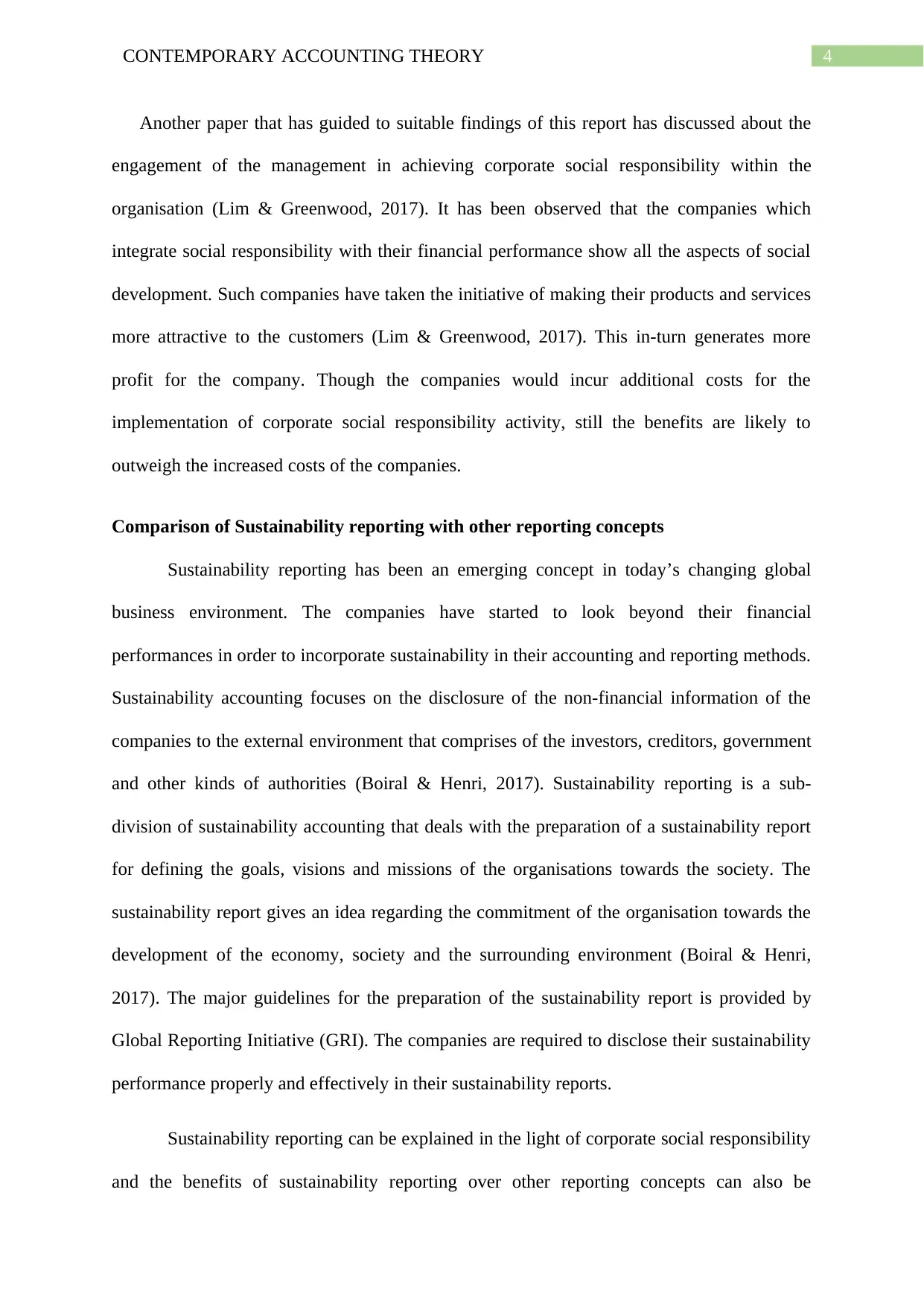
4CONTEMPORARY ACCOUNTING THEORY
Another paper that has guided to suitable findings of this report has discussed about the
engagement of the management in achieving corporate social responsibility within the
organisation (Lim & Greenwood, 2017). It has been observed that the companies which
integrate social responsibility with their financial performance show all the aspects of social
development. Such companies have taken the initiative of making their products and services
more attractive to the customers (Lim & Greenwood, 2017). This in-turn generates more
profit for the company. Though the companies would incur additional costs for the
implementation of corporate social responsibility activity, still the benefits are likely to
outweigh the increased costs of the companies.
Comparison of Sustainability reporting with other reporting concepts
Sustainability reporting has been an emerging concept in today’s changing global
business environment. The companies have started to look beyond their financial
performances in order to incorporate sustainability in their accounting and reporting methods.
Sustainability accounting focuses on the disclosure of the non-financial information of the
companies to the external environment that comprises of the investors, creditors, government
and other kinds of authorities (Boiral & Henri, 2017). Sustainability reporting is a sub-
division of sustainability accounting that deals with the preparation of a sustainability report
for defining the goals, visions and missions of the organisations towards the society. The
sustainability report gives an idea regarding the commitment of the organisation towards the
development of the economy, society and the surrounding environment (Boiral & Henri,
2017). The major guidelines for the preparation of the sustainability report is provided by
Global Reporting Initiative (GRI). The companies are required to disclose their sustainability
performance properly and effectively in their sustainability reports.
Sustainability reporting can be explained in the light of corporate social responsibility
and the benefits of sustainability reporting over other reporting concepts can also be
Another paper that has guided to suitable findings of this report has discussed about the
engagement of the management in achieving corporate social responsibility within the
organisation (Lim & Greenwood, 2017). It has been observed that the companies which
integrate social responsibility with their financial performance show all the aspects of social
development. Such companies have taken the initiative of making their products and services
more attractive to the customers (Lim & Greenwood, 2017). This in-turn generates more
profit for the company. Though the companies would incur additional costs for the
implementation of corporate social responsibility activity, still the benefits are likely to
outweigh the increased costs of the companies.
Comparison of Sustainability reporting with other reporting concepts
Sustainability reporting has been an emerging concept in today’s changing global
business environment. The companies have started to look beyond their financial
performances in order to incorporate sustainability in their accounting and reporting methods.
Sustainability accounting focuses on the disclosure of the non-financial information of the
companies to the external environment that comprises of the investors, creditors, government
and other kinds of authorities (Boiral & Henri, 2017). Sustainability reporting is a sub-
division of sustainability accounting that deals with the preparation of a sustainability report
for defining the goals, visions and missions of the organisations towards the society. The
sustainability report gives an idea regarding the commitment of the organisation towards the
development of the economy, society and the surrounding environment (Boiral & Henri,
2017). The major guidelines for the preparation of the sustainability report is provided by
Global Reporting Initiative (GRI). The companies are required to disclose their sustainability
performance properly and effectively in their sustainability reports.
Sustainability reporting can be explained in the light of corporate social responsibility
and the benefits of sustainability reporting over other reporting concepts can also be
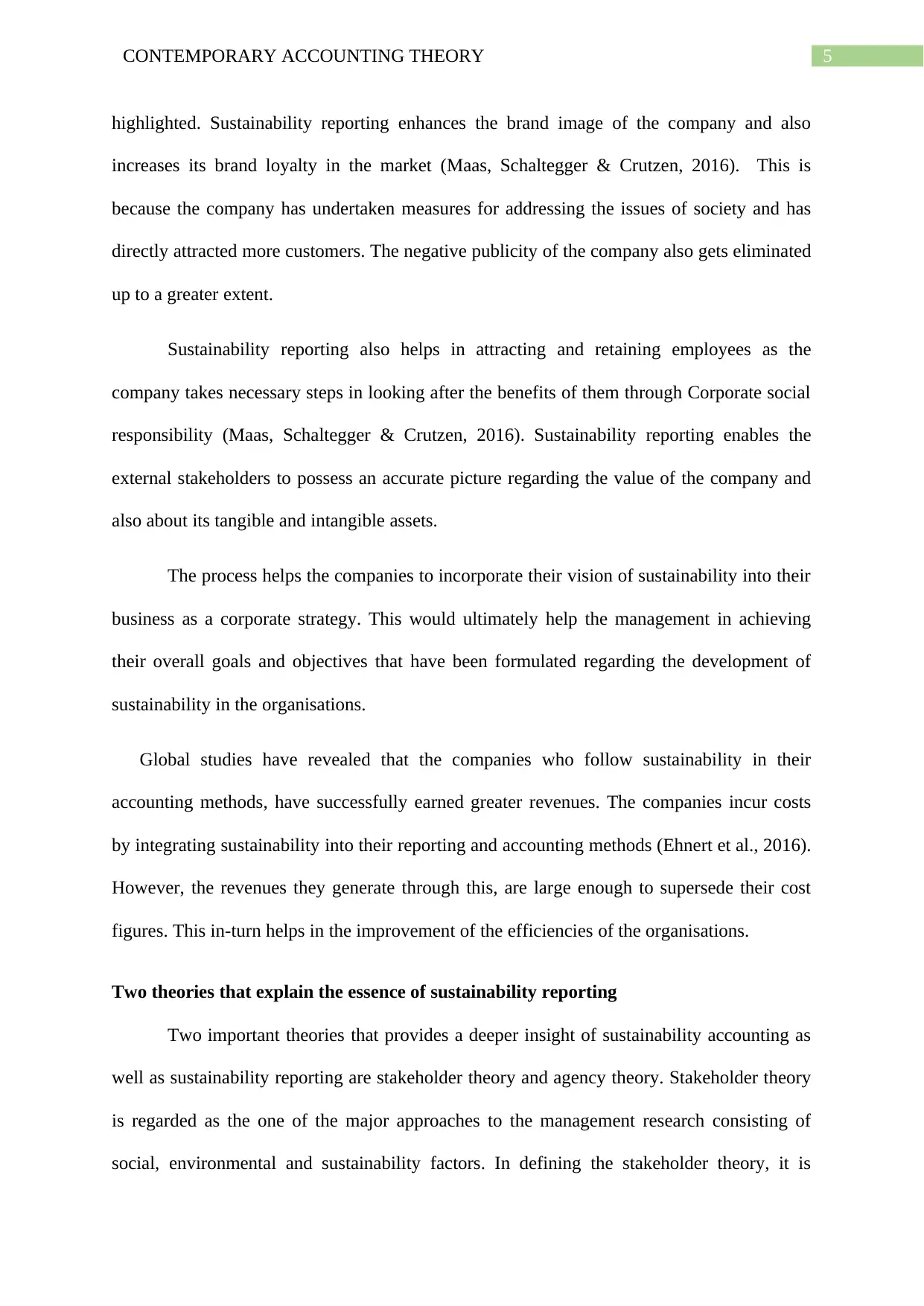
5CONTEMPORARY ACCOUNTING THEORY
highlighted. Sustainability reporting enhances the brand image of the company and also
increases its brand loyalty in the market (Maas, Schaltegger & Crutzen, 2016). This is
because the company has undertaken measures for addressing the issues of society and has
directly attracted more customers. The negative publicity of the company also gets eliminated
up to a greater extent.
Sustainability reporting also helps in attracting and retaining employees as the
company takes necessary steps in looking after the benefits of them through Corporate social
responsibility (Maas, Schaltegger & Crutzen, 2016). Sustainability reporting enables the
external stakeholders to possess an accurate picture regarding the value of the company and
also about its tangible and intangible assets.
The process helps the companies to incorporate their vision of sustainability into their
business as a corporate strategy. This would ultimately help the management in achieving
their overall goals and objectives that have been formulated regarding the development of
sustainability in the organisations.
Global studies have revealed that the companies who follow sustainability in their
accounting methods, have successfully earned greater revenues. The companies incur costs
by integrating sustainability into their reporting and accounting methods (Ehnert et al., 2016).
However, the revenues they generate through this, are large enough to supersede their cost
figures. This in-turn helps in the improvement of the efficiencies of the organisations.
Two theories that explain the essence of sustainability reporting
Two important theories that provides a deeper insight of sustainability accounting as
well as sustainability reporting are stakeholder theory and agency theory. Stakeholder theory
is regarded as the one of the major approaches to the management research consisting of
social, environmental and sustainability factors. In defining the stakeholder theory, it is
highlighted. Sustainability reporting enhances the brand image of the company and also
increases its brand loyalty in the market (Maas, Schaltegger & Crutzen, 2016). This is
because the company has undertaken measures for addressing the issues of society and has
directly attracted more customers. The negative publicity of the company also gets eliminated
up to a greater extent.
Sustainability reporting also helps in attracting and retaining employees as the
company takes necessary steps in looking after the benefits of them through Corporate social
responsibility (Maas, Schaltegger & Crutzen, 2016). Sustainability reporting enables the
external stakeholders to possess an accurate picture regarding the value of the company and
also about its tangible and intangible assets.
The process helps the companies to incorporate their vision of sustainability into their
business as a corporate strategy. This would ultimately help the management in achieving
their overall goals and objectives that have been formulated regarding the development of
sustainability in the organisations.
Global studies have revealed that the companies who follow sustainability in their
accounting methods, have successfully earned greater revenues. The companies incur costs
by integrating sustainability into their reporting and accounting methods (Ehnert et al., 2016).
However, the revenues they generate through this, are large enough to supersede their cost
figures. This in-turn helps in the improvement of the efficiencies of the organisations.
Two theories that explain the essence of sustainability reporting
Two important theories that provides a deeper insight of sustainability accounting as
well as sustainability reporting are stakeholder theory and agency theory. Stakeholder theory
is regarded as the one of the major approaches to the management research consisting of
social, environmental and sustainability factors. In defining the stakeholder theory, it is
⊘ This is a preview!⊘
Do you want full access?
Subscribe today to unlock all pages.

Trusted by 1+ million students worldwide
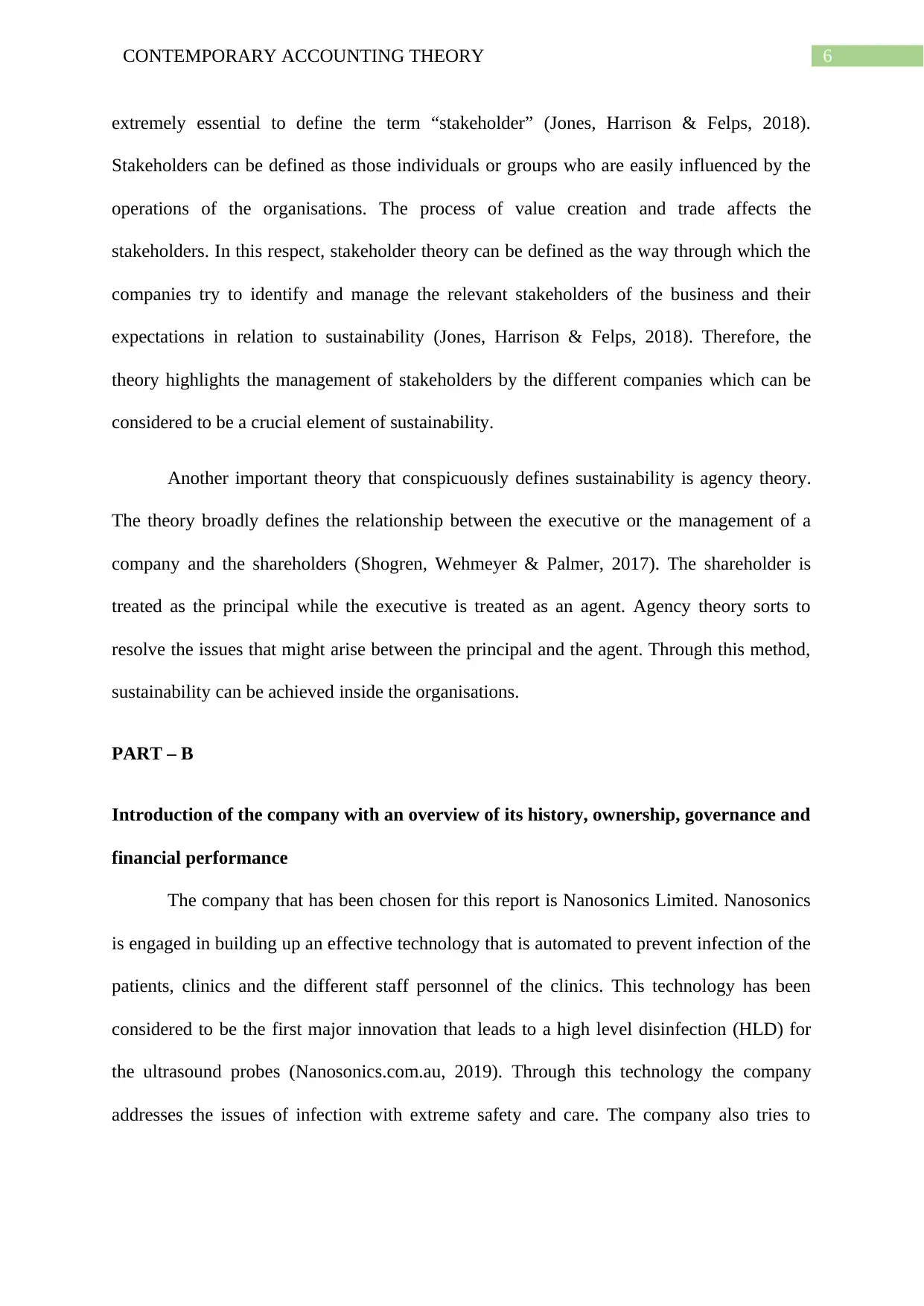
6CONTEMPORARY ACCOUNTING THEORY
extremely essential to define the term “stakeholder” (Jones, Harrison & Felps, 2018).
Stakeholders can be defined as those individuals or groups who are easily influenced by the
operations of the organisations. The process of value creation and trade affects the
stakeholders. In this respect, stakeholder theory can be defined as the way through which the
companies try to identify and manage the relevant stakeholders of the business and their
expectations in relation to sustainability (Jones, Harrison & Felps, 2018). Therefore, the
theory highlights the management of stakeholders by the different companies which can be
considered to be a crucial element of sustainability.
Another important theory that conspicuously defines sustainability is agency theory.
The theory broadly defines the relationship between the executive or the management of a
company and the shareholders (Shogren, Wehmeyer & Palmer, 2017). The shareholder is
treated as the principal while the executive is treated as an agent. Agency theory sorts to
resolve the issues that might arise between the principal and the agent. Through this method,
sustainability can be achieved inside the organisations.
PART – B
Introduction of the company with an overview of its history, ownership, governance and
financial performance
The company that has been chosen for this report is Nanosonics Limited. Nanosonics
is engaged in building up an effective technology that is automated to prevent infection of the
patients, clinics and the different staff personnel of the clinics. This technology has been
considered to be the first major innovation that leads to a high level disinfection (HLD) for
the ultrasound probes (Nanosonics.com.au, 2019). Through this technology the company
addresses the issues of infection with extreme safety and care. The company also tries to
extremely essential to define the term “stakeholder” (Jones, Harrison & Felps, 2018).
Stakeholders can be defined as those individuals or groups who are easily influenced by the
operations of the organisations. The process of value creation and trade affects the
stakeholders. In this respect, stakeholder theory can be defined as the way through which the
companies try to identify and manage the relevant stakeholders of the business and their
expectations in relation to sustainability (Jones, Harrison & Felps, 2018). Therefore, the
theory highlights the management of stakeholders by the different companies which can be
considered to be a crucial element of sustainability.
Another important theory that conspicuously defines sustainability is agency theory.
The theory broadly defines the relationship between the executive or the management of a
company and the shareholders (Shogren, Wehmeyer & Palmer, 2017). The shareholder is
treated as the principal while the executive is treated as an agent. Agency theory sorts to
resolve the issues that might arise between the principal and the agent. Through this method,
sustainability can be achieved inside the organisations.
PART – B
Introduction of the company with an overview of its history, ownership, governance and
financial performance
The company that has been chosen for this report is Nanosonics Limited. Nanosonics
is engaged in building up an effective technology that is automated to prevent infection of the
patients, clinics and the different staff personnel of the clinics. This technology has been
considered to be the first major innovation that leads to a high level disinfection (HLD) for
the ultrasound probes (Nanosonics.com.au, 2019). Through this technology the company
addresses the issues of infection with extreme safety and care. The company also tries to
Paraphrase This Document
Need a fresh take? Get an instant paraphrase of this document with our AI Paraphraser
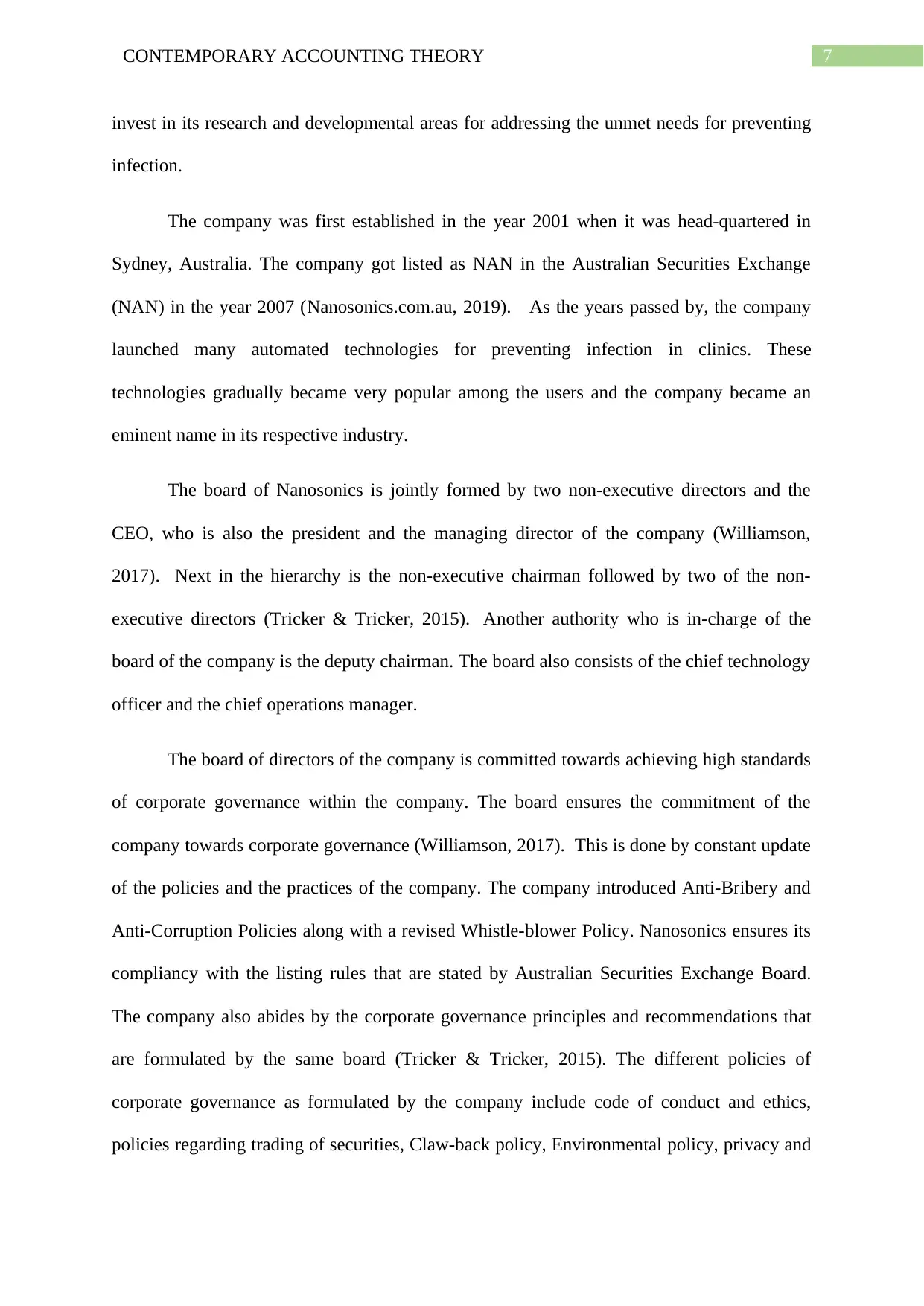
7CONTEMPORARY ACCOUNTING THEORY
invest in its research and developmental areas for addressing the unmet needs for preventing
infection.
The company was first established in the year 2001 when it was head-quartered in
Sydney, Australia. The company got listed as NAN in the Australian Securities Exchange
(NAN) in the year 2007 (Nanosonics.com.au, 2019). As the years passed by, the company
launched many automated technologies for preventing infection in clinics. These
technologies gradually became very popular among the users and the company became an
eminent name in its respective industry.
The board of Nanosonics is jointly formed by two non-executive directors and the
CEO, who is also the president and the managing director of the company (Williamson,
2017). Next in the hierarchy is the non-executive chairman followed by two of the non-
executive directors (Tricker & Tricker, 2015). Another authority who is in-charge of the
board of the company is the deputy chairman. The board also consists of the chief technology
officer and the chief operations manager.
The board of directors of the company is committed towards achieving high standards
of corporate governance within the company. The board ensures the commitment of the
company towards corporate governance (Williamson, 2017). This is done by constant update
of the policies and the practices of the company. The company introduced Anti-Bribery and
Anti-Corruption Policies along with a revised Whistle-blower Policy. Nanosonics ensures its
compliancy with the listing rules that are stated by Australian Securities Exchange Board.
The company also abides by the corporate governance principles and recommendations that
are formulated by the same board (Tricker & Tricker, 2015). The different policies of
corporate governance as formulated by the company include code of conduct and ethics,
policies regarding trading of securities, Claw-back policy, Environmental policy, privacy and
invest in its research and developmental areas for addressing the unmet needs for preventing
infection.
The company was first established in the year 2001 when it was head-quartered in
Sydney, Australia. The company got listed as NAN in the Australian Securities Exchange
(NAN) in the year 2007 (Nanosonics.com.au, 2019). As the years passed by, the company
launched many automated technologies for preventing infection in clinics. These
technologies gradually became very popular among the users and the company became an
eminent name in its respective industry.
The board of Nanosonics is jointly formed by two non-executive directors and the
CEO, who is also the president and the managing director of the company (Williamson,
2017). Next in the hierarchy is the non-executive chairman followed by two of the non-
executive directors (Tricker & Tricker, 2015). Another authority who is in-charge of the
board of the company is the deputy chairman. The board also consists of the chief technology
officer and the chief operations manager.
The board of directors of the company is committed towards achieving high standards
of corporate governance within the company. The board ensures the commitment of the
company towards corporate governance (Williamson, 2017). This is done by constant update
of the policies and the practices of the company. The company introduced Anti-Bribery and
Anti-Corruption Policies along with a revised Whistle-blower Policy. Nanosonics ensures its
compliancy with the listing rules that are stated by Australian Securities Exchange Board.
The company also abides by the corporate governance principles and recommendations that
are formulated by the same board (Tricker & Tricker, 2015). The different policies of
corporate governance as formulated by the company include code of conduct and ethics,
policies regarding trading of securities, Claw-back policy, Environmental policy, privacy and
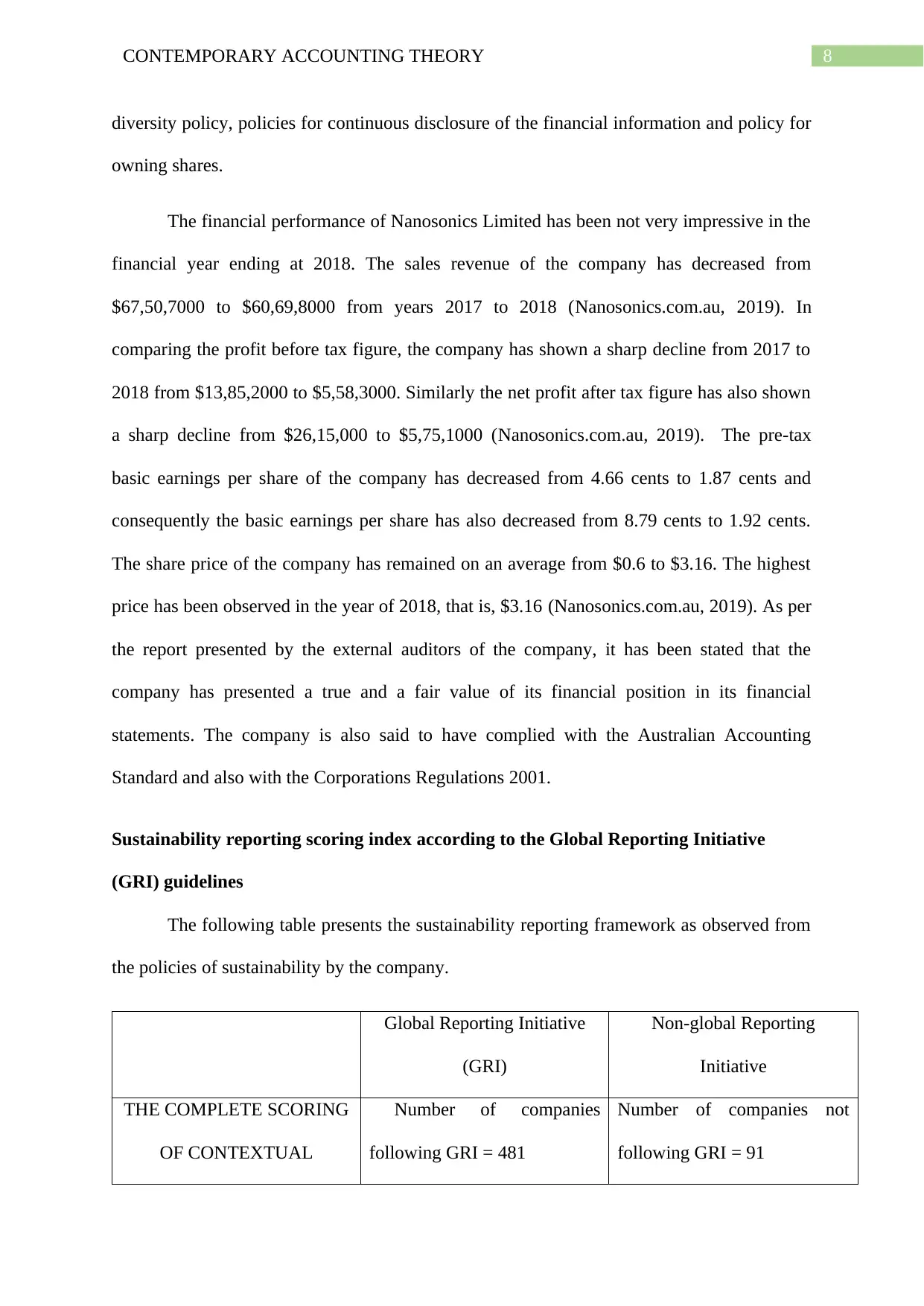
8CONTEMPORARY ACCOUNTING THEORY
diversity policy, policies for continuous disclosure of the financial information and policy for
owning shares.
The financial performance of Nanosonics Limited has been not very impressive in the
financial year ending at 2018. The sales revenue of the company has decreased from
$67,50,7000 to $60,69,8000 from years 2017 to 2018 (Nanosonics.com.au, 2019). In
comparing the profit before tax figure, the company has shown a sharp decline from 2017 to
2018 from $13,85,2000 to $5,58,3000. Similarly the net profit after tax figure has also shown
a sharp decline from $26,15,000 to $5,75,1000 (Nanosonics.com.au, 2019). The pre-tax
basic earnings per share of the company has decreased from 4.66 cents to 1.87 cents and
consequently the basic earnings per share has also decreased from 8.79 cents to 1.92 cents.
The share price of the company has remained on an average from $0.6 to $3.16. The highest
price has been observed in the year of 2018, that is, $3.16 (Nanosonics.com.au, 2019). As per
the report presented by the external auditors of the company, it has been stated that the
company has presented a true and a fair value of its financial position in its financial
statements. The company is also said to have complied with the Australian Accounting
Standard and also with the Corporations Regulations 2001.
Sustainability reporting scoring index according to the Global Reporting Initiative
(GRI) guidelines
The following table presents the sustainability reporting framework as observed from
the policies of sustainability by the company.
Global Reporting Initiative
(GRI)
Non-global Reporting
Initiative
THE COMPLETE SCORING
OF CONTEXTUAL
Number of companies
following GRI = 481
Number of companies not
following GRI = 91
diversity policy, policies for continuous disclosure of the financial information and policy for
owning shares.
The financial performance of Nanosonics Limited has been not very impressive in the
financial year ending at 2018. The sales revenue of the company has decreased from
$67,50,7000 to $60,69,8000 from years 2017 to 2018 (Nanosonics.com.au, 2019). In
comparing the profit before tax figure, the company has shown a sharp decline from 2017 to
2018 from $13,85,2000 to $5,58,3000. Similarly the net profit after tax figure has also shown
a sharp decline from $26,15,000 to $5,75,1000 (Nanosonics.com.au, 2019). The pre-tax
basic earnings per share of the company has decreased from 4.66 cents to 1.87 cents and
consequently the basic earnings per share has also decreased from 8.79 cents to 1.92 cents.
The share price of the company has remained on an average from $0.6 to $3.16. The highest
price has been observed in the year of 2018, that is, $3.16 (Nanosonics.com.au, 2019). As per
the report presented by the external auditors of the company, it has been stated that the
company has presented a true and a fair value of its financial position in its financial
statements. The company is also said to have complied with the Australian Accounting
Standard and also with the Corporations Regulations 2001.
Sustainability reporting scoring index according to the Global Reporting Initiative
(GRI) guidelines
The following table presents the sustainability reporting framework as observed from
the policies of sustainability by the company.
Global Reporting Initiative
(GRI)
Non-global Reporting
Initiative
THE COMPLETE SCORING
OF CONTEXTUAL
Number of companies
following GRI = 481
Number of companies not
following GRI = 91
⊘ This is a preview!⊘
Do you want full access?
Subscribe today to unlock all pages.

Trusted by 1+ million students worldwide
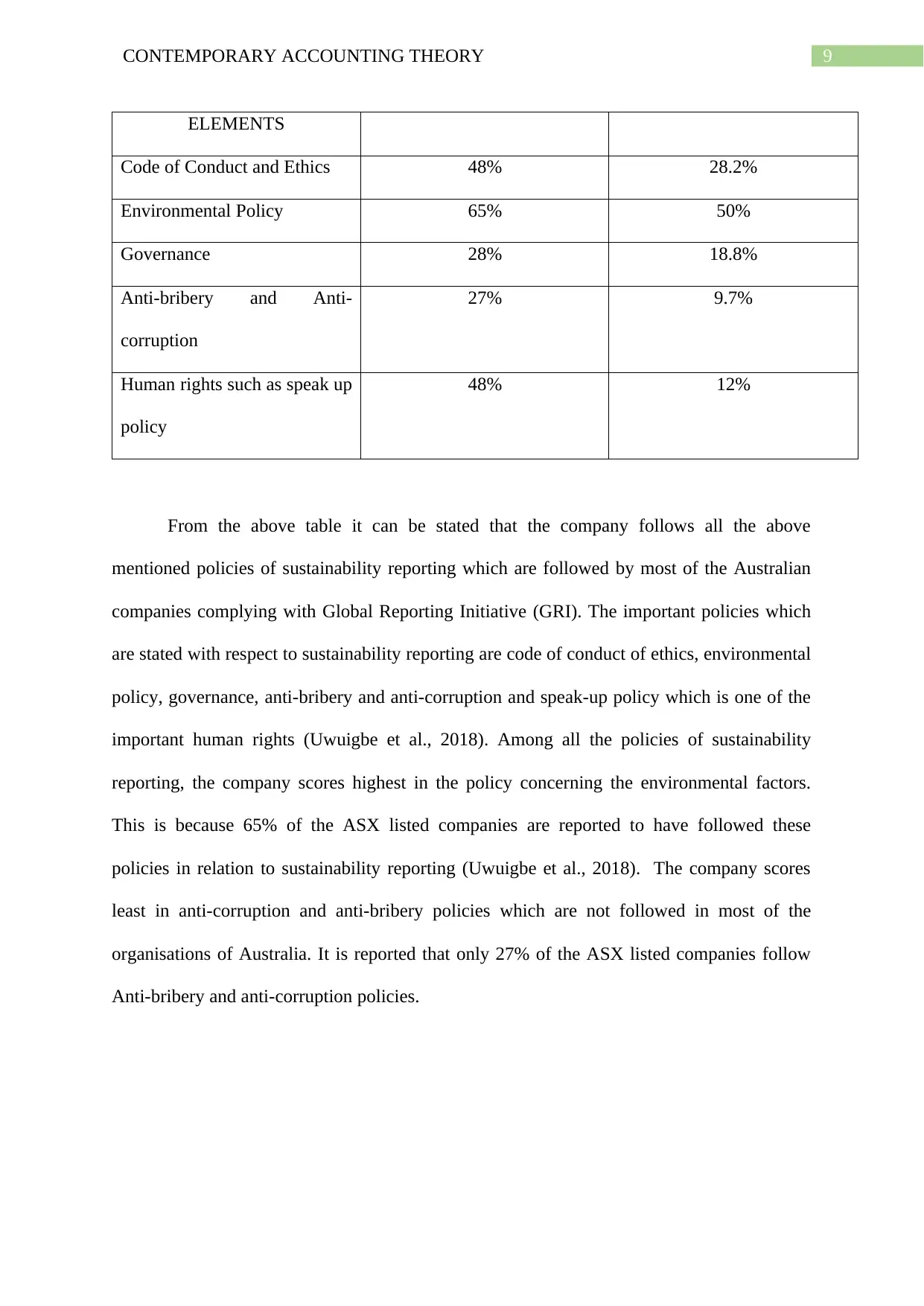
9CONTEMPORARY ACCOUNTING THEORY
ELEMENTS
Code of Conduct and Ethics 48% 28.2%
Environmental Policy 65% 50%
Governance 28% 18.8%
Anti-bribery and Anti-
corruption
27% 9.7%
Human rights such as speak up
policy
48% 12%
From the above table it can be stated that the company follows all the above
mentioned policies of sustainability reporting which are followed by most of the Australian
companies complying with Global Reporting Initiative (GRI). The important policies which
are stated with respect to sustainability reporting are code of conduct of ethics, environmental
policy, governance, anti-bribery and anti-corruption and speak-up policy which is one of the
important human rights (Uwuigbe et al., 2018). Among all the policies of sustainability
reporting, the company scores highest in the policy concerning the environmental factors.
This is because 65% of the ASX listed companies are reported to have followed these
policies in relation to sustainability reporting (Uwuigbe et al., 2018). The company scores
least in anti-corruption and anti-bribery policies which are not followed in most of the
organisations of Australia. It is reported that only 27% of the ASX listed companies follow
Anti-bribery and anti-corruption policies.
ELEMENTS
Code of Conduct and Ethics 48% 28.2%
Environmental Policy 65% 50%
Governance 28% 18.8%
Anti-bribery and Anti-
corruption
27% 9.7%
Human rights such as speak up
policy
48% 12%
From the above table it can be stated that the company follows all the above
mentioned policies of sustainability reporting which are followed by most of the Australian
companies complying with Global Reporting Initiative (GRI). The important policies which
are stated with respect to sustainability reporting are code of conduct of ethics, environmental
policy, governance, anti-bribery and anti-corruption and speak-up policy which is one of the
important human rights (Uwuigbe et al., 2018). Among all the policies of sustainability
reporting, the company scores highest in the policy concerning the environmental factors.
This is because 65% of the ASX listed companies are reported to have followed these
policies in relation to sustainability reporting (Uwuigbe et al., 2018). The company scores
least in anti-corruption and anti-bribery policies which are not followed in most of the
organisations of Australia. It is reported that only 27% of the ASX listed companies follow
Anti-bribery and anti-corruption policies.
Paraphrase This Document
Need a fresh take? Get an instant paraphrase of this document with our AI Paraphraser
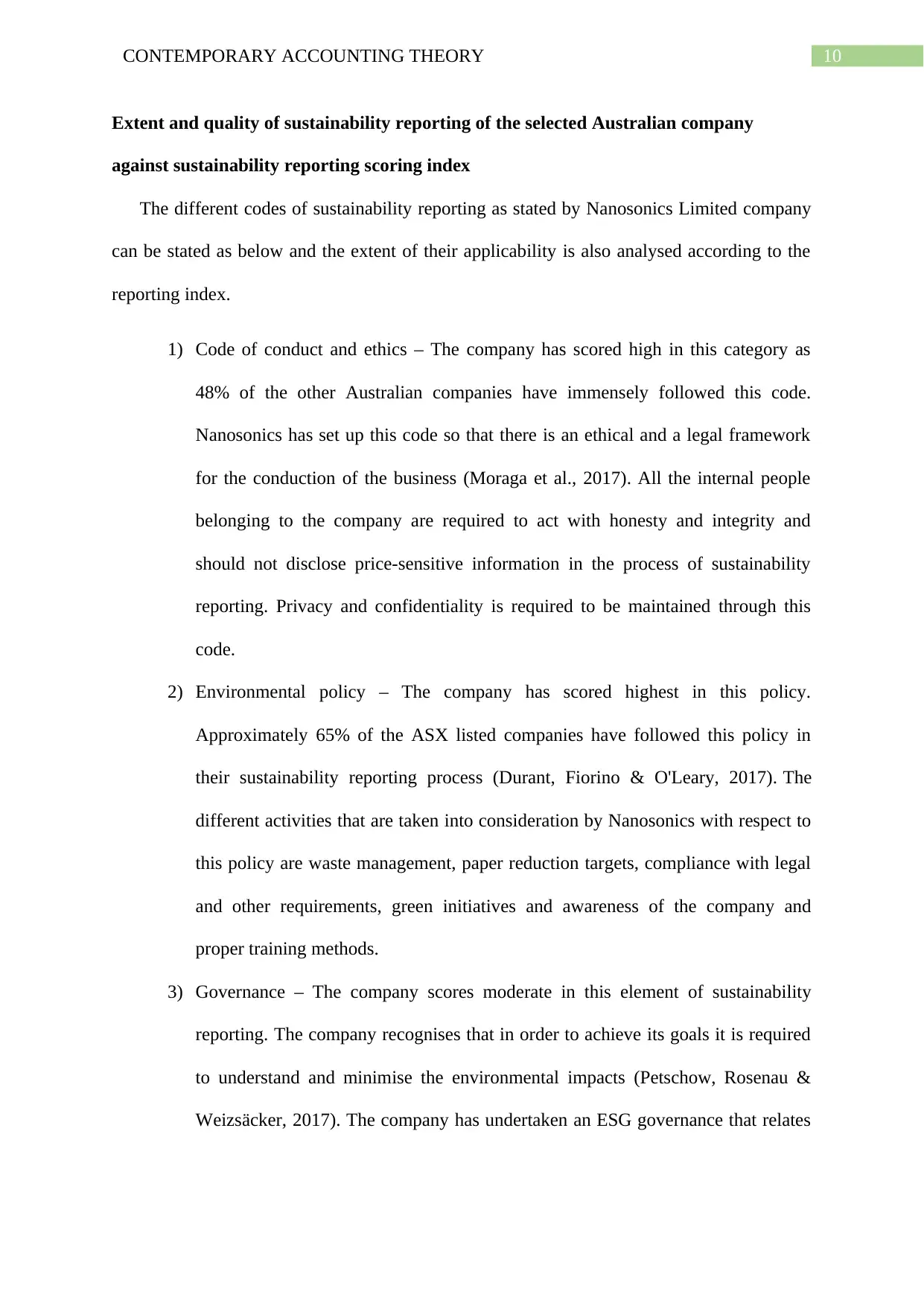
10CONTEMPORARY ACCOUNTING THEORY
Extent and quality of sustainability reporting of the selected Australian company
against sustainability reporting scoring index
The different codes of sustainability reporting as stated by Nanosonics Limited company
can be stated as below and the extent of their applicability is also analysed according to the
reporting index.
1) Code of conduct and ethics – The company has scored high in this category as
48% of the other Australian companies have immensely followed this code.
Nanosonics has set up this code so that there is an ethical and a legal framework
for the conduction of the business (Moraga et al., 2017). All the internal people
belonging to the company are required to act with honesty and integrity and
should not disclose price-sensitive information in the process of sustainability
reporting. Privacy and confidentiality is required to be maintained through this
code.
2) Environmental policy – The company has scored highest in this policy.
Approximately 65% of the ASX listed companies have followed this policy in
their sustainability reporting process (Durant, Fiorino & O'Leary, 2017). The
different activities that are taken into consideration by Nanosonics with respect to
this policy are waste management, paper reduction targets, compliance with legal
and other requirements, green initiatives and awareness of the company and
proper training methods.
3) Governance – The company scores moderate in this element of sustainability
reporting. The company recognises that in order to achieve its goals it is required
to understand and minimise the environmental impacts (Petschow, Rosenau &
Weizsäcker, 2017). The company has undertaken an ESG governance that relates
Extent and quality of sustainability reporting of the selected Australian company
against sustainability reporting scoring index
The different codes of sustainability reporting as stated by Nanosonics Limited company
can be stated as below and the extent of their applicability is also analysed according to the
reporting index.
1) Code of conduct and ethics – The company has scored high in this category as
48% of the other Australian companies have immensely followed this code.
Nanosonics has set up this code so that there is an ethical and a legal framework
for the conduction of the business (Moraga et al., 2017). All the internal people
belonging to the company are required to act with honesty and integrity and
should not disclose price-sensitive information in the process of sustainability
reporting. Privacy and confidentiality is required to be maintained through this
code.
2) Environmental policy – The company has scored highest in this policy.
Approximately 65% of the ASX listed companies have followed this policy in
their sustainability reporting process (Durant, Fiorino & O'Leary, 2017). The
different activities that are taken into consideration by Nanosonics with respect to
this policy are waste management, paper reduction targets, compliance with legal
and other requirements, green initiatives and awareness of the company and
proper training methods.
3) Governance – The company scores moderate in this element of sustainability
reporting. The company recognises that in order to achieve its goals it is required
to understand and minimise the environmental impacts (Petschow, Rosenau &
Weizsäcker, 2017). The company has undertaken an ESG governance that relates
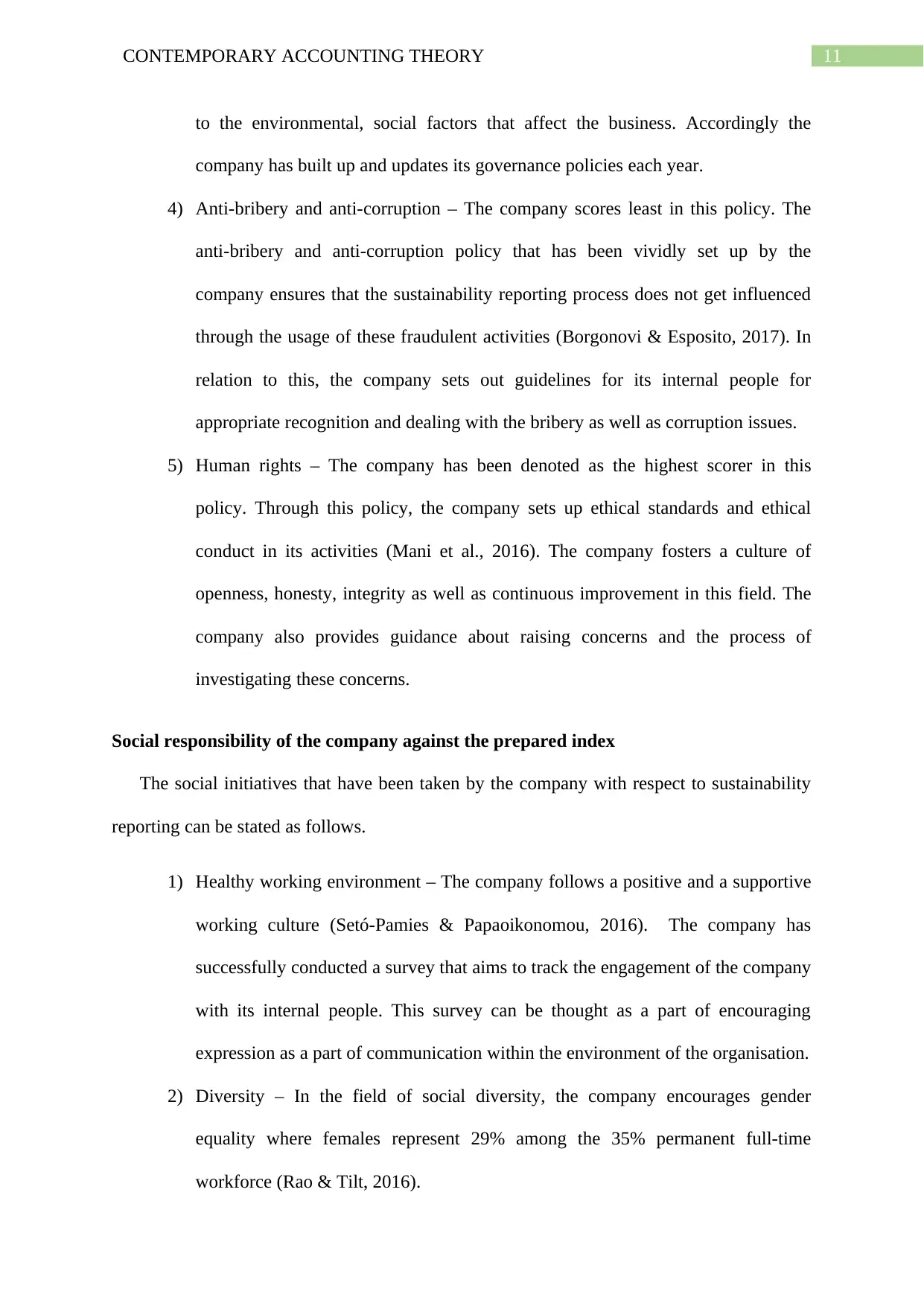
11CONTEMPORARY ACCOUNTING THEORY
to the environmental, social factors that affect the business. Accordingly the
company has built up and updates its governance policies each year.
4) Anti-bribery and anti-corruption – The company scores least in this policy. The
anti-bribery and anti-corruption policy that has been vividly set up by the
company ensures that the sustainability reporting process does not get influenced
through the usage of these fraudulent activities (Borgonovi & Esposito, 2017). In
relation to this, the company sets out guidelines for its internal people for
appropriate recognition and dealing with the bribery as well as corruption issues.
5) Human rights – The company has been denoted as the highest scorer in this
policy. Through this policy, the company sets up ethical standards and ethical
conduct in its activities (Mani et al., 2016). The company fosters a culture of
openness, honesty, integrity as well as continuous improvement in this field. The
company also provides guidance about raising concerns and the process of
investigating these concerns.
Social responsibility of the company against the prepared index
The social initiatives that have been taken by the company with respect to sustainability
reporting can be stated as follows.
1) Healthy working environment – The company follows a positive and a supportive
working culture (Setó-Pamies & Papaoikonomou, 2016). The company has
successfully conducted a survey that aims to track the engagement of the company
with its internal people. This survey can be thought as a part of encouraging
expression as a part of communication within the environment of the organisation.
2) Diversity – In the field of social diversity, the company encourages gender
equality where females represent 29% among the 35% permanent full-time
workforce (Rao & Tilt, 2016).
to the environmental, social factors that affect the business. Accordingly the
company has built up and updates its governance policies each year.
4) Anti-bribery and anti-corruption – The company scores least in this policy. The
anti-bribery and anti-corruption policy that has been vividly set up by the
company ensures that the sustainability reporting process does not get influenced
through the usage of these fraudulent activities (Borgonovi & Esposito, 2017). In
relation to this, the company sets out guidelines for its internal people for
appropriate recognition and dealing with the bribery as well as corruption issues.
5) Human rights – The company has been denoted as the highest scorer in this
policy. Through this policy, the company sets up ethical standards and ethical
conduct in its activities (Mani et al., 2016). The company fosters a culture of
openness, honesty, integrity as well as continuous improvement in this field. The
company also provides guidance about raising concerns and the process of
investigating these concerns.
Social responsibility of the company against the prepared index
The social initiatives that have been taken by the company with respect to sustainability
reporting can be stated as follows.
1) Healthy working environment – The company follows a positive and a supportive
working culture (Setó-Pamies & Papaoikonomou, 2016). The company has
successfully conducted a survey that aims to track the engagement of the company
with its internal people. This survey can be thought as a part of encouraging
expression as a part of communication within the environment of the organisation.
2) Diversity – In the field of social diversity, the company encourages gender
equality where females represent 29% among the 35% permanent full-time
workforce (Rao & Tilt, 2016).
⊘ This is a preview!⊘
Do you want full access?
Subscribe today to unlock all pages.

Trusted by 1+ million students worldwide
1 out of 18
Related Documents
Your All-in-One AI-Powered Toolkit for Academic Success.
+13062052269
info@desklib.com
Available 24*7 on WhatsApp / Email
![[object Object]](/_next/static/media/star-bottom.7253800d.svg)
Unlock your academic potential
Copyright © 2020–2025 A2Z Services. All Rights Reserved. Developed and managed by ZUCOL.





